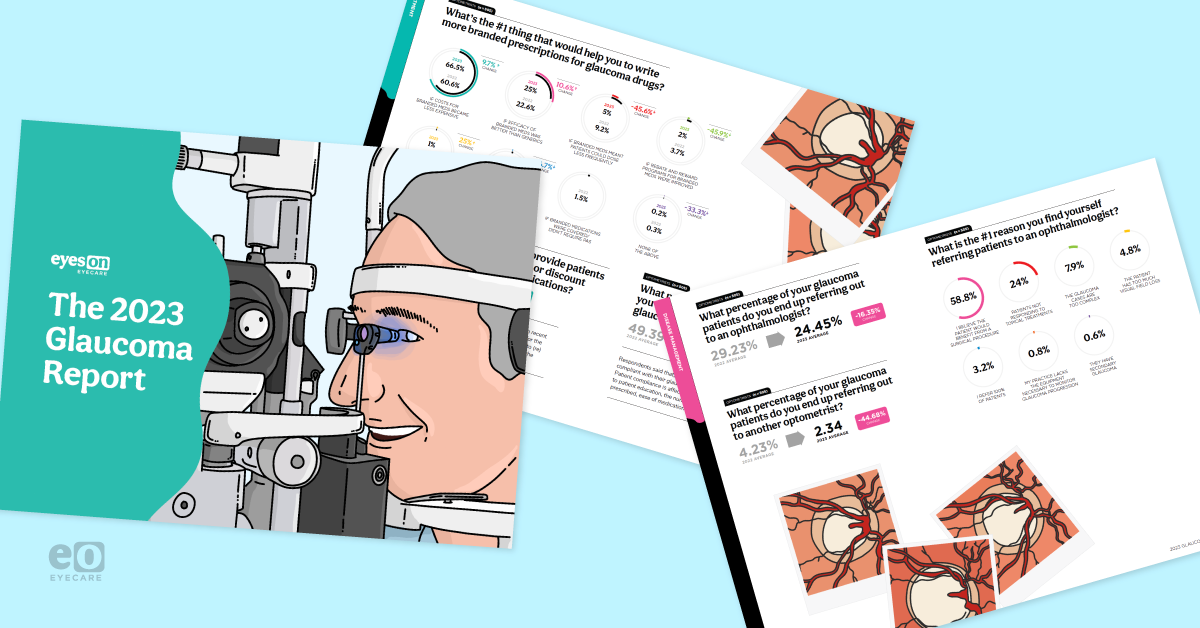Glaucoma is the second leading cause of blindness worldwide, and roughly three million people in the United States have been diagnosed with the disease.
1 According to the Centers for Disease Control and Prevention (CDC),
half of all people with glaucoma don’t even know that they have the condition.
2As the global population ages, eyecare practitioners around the world must expand their knowledge of
glaucoma diagnosis, management, and treatment. Blindness caused by glaucoma is irreversible; luckily, glaucoma therapeutics have progressed in leaps and bounds even in the last decade to mitigate the severity of visual loss.
In May of 2023, we surveyed 505 optometrists in the US and Canada who treated glaucoma. The result of this survey is the 2023 Glaucoma Report. As with all Eyes On Eyecare reports, the 2023 Glaucoma Report is absolutely free to download!
Download the 2023 Glaucoma Report now, or keep reading for a sneak peek at our findings!
The 2023 Glaucoma Report
This report outlines trends in glaucoma diagnosis, management, and treatment with recent survey data and detailed infographics.
The 2023 Glaucoma Report covers:
- Glaucoma prevalence and focus: How many of your patients have been diagnosed with glaucoma? How important is glaucoma to your practice?
- Confidence in diagnosing, managing, and treating glaucoma: How comfortable are optometrists diagnosing glaucoma? How comfortable are they with treating and managing the disease?
- Top glaucoma treatments: What are the top first-line and second-line treatments for glaucoma? How comfortable are optometrists with the variety of glaucoma treatments available?
- Referrals and co-management: What do optometrists think about the co-management process for glaucoma? How many patients are they referring to other specialists, and why?
- And more!
Confidence in diagnosing and treating glaucoma is high
This year, optometrists estimated that, on average, 16% of their patients have been diagnosed with glaucoma, a 10% drop from the estimation made by last year’s set of respondents. Overall confidence in diagnosis was 7.89/10, 2.47% higher than last year.
Optometrists are using a variety of technologies to diagnose glaucoma, but the most popular are visual field analyzers, optical coherence tomography (OCT), fundus photography, and pachymetry.
Confidence in treatment is high, with SLT as the most popular second-line treatment
Optometrists’ average confidence in treating glaucoma was high again this year at 7.54/10, a small increase from last year.
Considering best practices in the treatment of glaucoma, it will come as no surprise that
topical medications were the first-line treatment of choice this year. Once again, optometrists noted selective laser trabeculoplasty (SLT) as their go-to second-line treatment for mild to moderate
open-angle glaucoma.
Interestingly, the
popularity of SLT has risen slightly since the
2021 report, in which roughly 6% of respondents identified it as a top first-line treatment—this year,
10% of respondents chose SLT as their go-to first-line treatment.
The glaucoma co-management process is improving but still has a ways to go
Last year, optometrists ranked the co-management process in their practice under a 7/10; this year, that average has risen to a
7.1/10. This year’s survey conveyed a marginal increase in
referrals from ODs to their ophthalmology colleagues. In most cases, the patient's need was driven by potential benefits from a surgical procedure, or the patient was not responding to topical treatments.
This is a crucial development as optometrists and ophthalmologists find themselves more often working collaboratively to manage complex glaucoma cases and ensure patients maintain access to the best possible care.
Learn more about the state of glaucoma treatment and management by downloading the free report!


